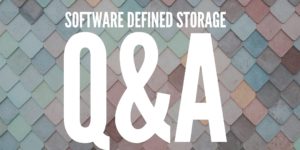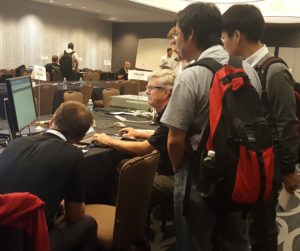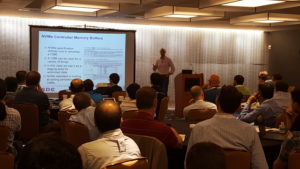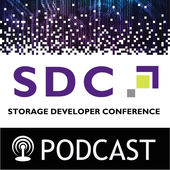Virtually any storage solution is more parts software than hardware. Having said this, users don’t care as much about the percentage of hardware vs. software. They want their consumption experience to be easy and fast to start up, with a pay-as-you-grow model and with the ability to scale without limits. So, it should not be a shock that real IT organizations are using software-only on standard servers to deliver storage to their customers. What’s more, this type of storage can be powered by open source.
At the upcoming SNIA Data Storage Innovation Conference, we are looking forward to discussing software-defined storage (SDS) from a user experience perspective with examples of OpenStack Swift providing an engine for building SDS clusters with any mixed combination of standard server and HDD hardware in a way that is simple enough for any enterprise to dynamically scale.
Swift is a highly available, distributed, scalable object store available as open source. It is designed to handle non-relational (that is, not just simple row-column data) or unstructured data at large scale with high availability and durability. For example, it can be used to store files, videos, documents, analytics results, Web content, drawings, voice recordings, images, maps, musical scores, pictures, or multimedia. Organizations can use Swift to store large amounts of data efficiently, safely, and cheaply. It scales horizontally without any single point of failure. It offers a single multi-tenant storage system for all applications, the ability to use low-cost industry-standard servers and drives, and a rich ecosystem of tools and libraries. It can serve the needs of any service provider or enterprise working in a cloud environment, regardless of whether the installation is using other OpenStack components.
I know what you are thinking, storage is too critical, so it will never work this way. But the same was said >25 years go when using RAID was seen as too risky given solutions would acknowledge writes while the data was in cache prior to being written to disk. The same was also said >15 years ago when VMware was seen as not robust enough to run any manner of demanding or critical application. Replicas and Erasure Codes are analogous to RAID 1 and RAID 5 respectively, and the uniquely as possible distribution of data behind a single namespace abstracts standard hardware like server virtualization.
Interested in hearing more? Come check out my DSI session, “Swift Use Cases with SwiftStack,” where we look forward to sharing how this new type of storage can work, and to suspend your disbelief that this storage can be enterprise-grade.
 The SNIA Networking Storage Forum (NSF) recently hosted a live webcast, What Software Defined Storage Means for Storage Networking where our experts, Ted Vojnovich and Fred Bower explained what makes software defined storage (SDS) different from traditional storage. If you missed the live event, you can watch it on-demand at your convenience. We had several questions at the live event and here are our experts’ answers to them all:
Q. Are there cases where SDS can still work with legacy storage so that high priority flows, online transaction processing (OLTP) can use SAN for the legacy storage while not so high priority and backup data flows utilize the SDS infrastructure? Read More
The SNIA Networking Storage Forum (NSF) recently hosted a live webcast, What Software Defined Storage Means for Storage Networking where our experts, Ted Vojnovich and Fred Bower explained what makes software defined storage (SDS) different from traditional storage. If you missed the live event, you can watch it on-demand at your convenience. We had several questions at the live event and here are our experts’ answers to them all:
Q. Are there cases where SDS can still work with legacy storage so that high priority flows, online transaction processing (OLTP) can use SAN for the legacy storage while not so high priority and backup data flows utilize the SDS infrastructure? Read More
 The SNIA Networking Storage Forum (NSF) recently hosted a live webcast, What Software Defined Storage Means for Storage Networking where our experts, Ted Vojnovich and Fred Bower explained what makes software defined storage (SDS) different from traditional storage. If you missed the live event, you can watch it on-demand at your convenience. We had several questions at the live event and here are our experts’ answers to them all:
Q. Are there cases where SDS can still work with legacy storage so that high priority flows, online transaction processing (OLTP) can use SAN for the legacy storage while not so high priority and backup data flows utilize the SDS infrastructure? Read More
The SNIA Networking Storage Forum (NSF) recently hosted a live webcast, What Software Defined Storage Means for Storage Networking where our experts, Ted Vojnovich and Fred Bower explained what makes software defined storage (SDS) different from traditional storage. If you missed the live event, you can watch it on-demand at your convenience. We had several questions at the live event and here are our experts’ answers to them all:
Q. Are there cases where SDS can still work with legacy storage so that high priority flows, online transaction processing (OLTP) can use SAN for the legacy storage while not so high priority and backup data flows utilize the SDS infrastructure? Read More
 c Storage, and SMB3 plugfests; ten Birds-of-a-Feather Sessions, and amazing networking among 450+ attendees. Sessions on NVMe over Fabrics won the title of most attended, but Persistent Memory, Object Storage, and Performance were right behind. Many thanks to SDC 2016 Sponsors, who engaged attendees in exciting technology discussions.
c Storage, and SMB3 plugfests; ten Birds-of-a-Feather Sessions, and amazing networking among 450+ attendees. Sessions on NVMe over Fabrics won the title of most attended, but Persistent Memory, Object Storage, and Performance were right behind. Many thanks to SDC 2016 Sponsors, who engaged attendees in exciting technology discussions. You’ll want to stream keynotes from Citigroup, Toshiba, DSSD, Los Alamos National Labs, Broadcom, Microsemi, and Intel – they’re available now on demand on SNIA’s YouTube channel,
You’ll want to stream keynotes from Citigroup, Toshiba, DSSD, Los Alamos National Labs, Broadcom, Microsemi, and Intel – they’re available now on demand on SNIA’s YouTube channel,  can get a “sound bite” of what to expect by downloading SDC podcasts via
can get a “sound bite” of what to expect by downloading SDC podcasts via